wheel alignment CHEVROLET COLORADO 2007 1.G Owners Manual
[x] Cancel search | Manufacturer: CHEVROLET, Model Year: 2007, Model line: COLORADO, Model: CHEVROLET COLORADO 2007 1.GPages: 496, PDF Size: 2.7 MB
Page 322 of 496
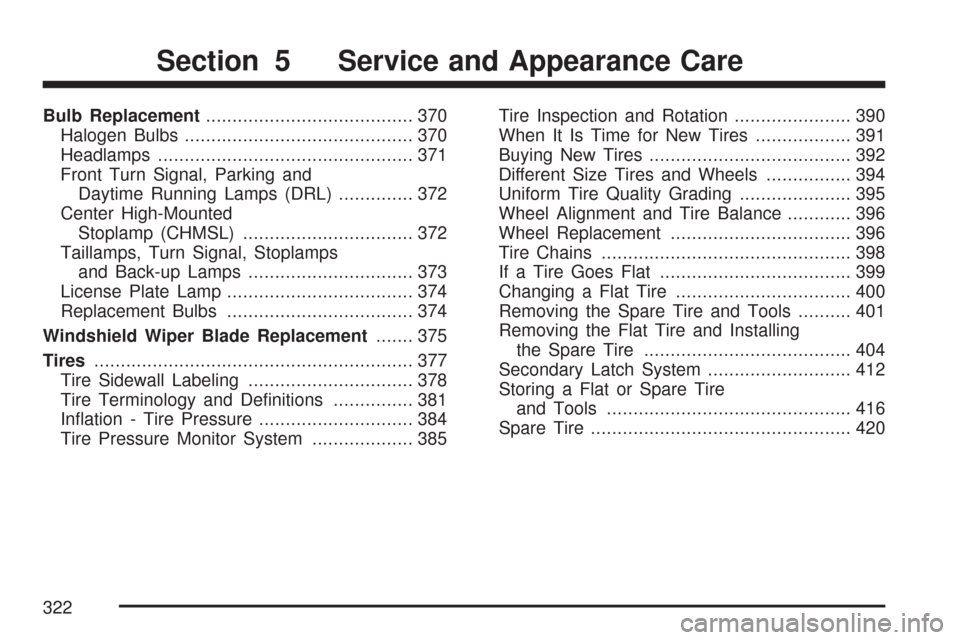
Bulb Replacement....................................... 370
Halogen Bulbs........................................... 370
Headlamps................................................ 371
Front Turn Signal, Parking and
Daytime Running Lamps (DRL).............. 372
Center High-Mounted
Stoplamp (CHMSL)................................ 372
Taillamps, Turn Signal, Stoplamps
and Back-up Lamps............................... 373
License Plate Lamp................................... 374
Replacement Bulbs................................... 374
Windshield Wiper Blade Replacement....... 375
Tires............................................................ 377
Tire Sidewall Labeling............................... 378
Tire Terminology and De�nitions............... 381
In�ation - Tire Pressure............................. 384
Tire Pressure Monitor System................... 385Tire Inspection and Rotation...................... 390
When It Is Time for New Tires.................. 391
Buying New Tires...................................... 392
Different Size Tires and Wheels................ 394
Uniform Tire Quality Grading..................... 395
Wheel Alignment and Tire Balance............ 396
Wheel Replacement.................................. 396
Tire Chains............................................... 398
If a Tire Goes Flat.................................... 399
Changing a Flat Tire................................. 400
Removing the Spare Tire and Tools.......... 401
Removing the Flat Tire and Installing
the Spare Tire....................................... 404
Secondary Latch System........................... 412
Storing a Flat or Spare Tire
and Tools.............................................. 416
Spare Tire................................................. 420
Section 5 Service and Appearance Care
322
Page 390 of 496
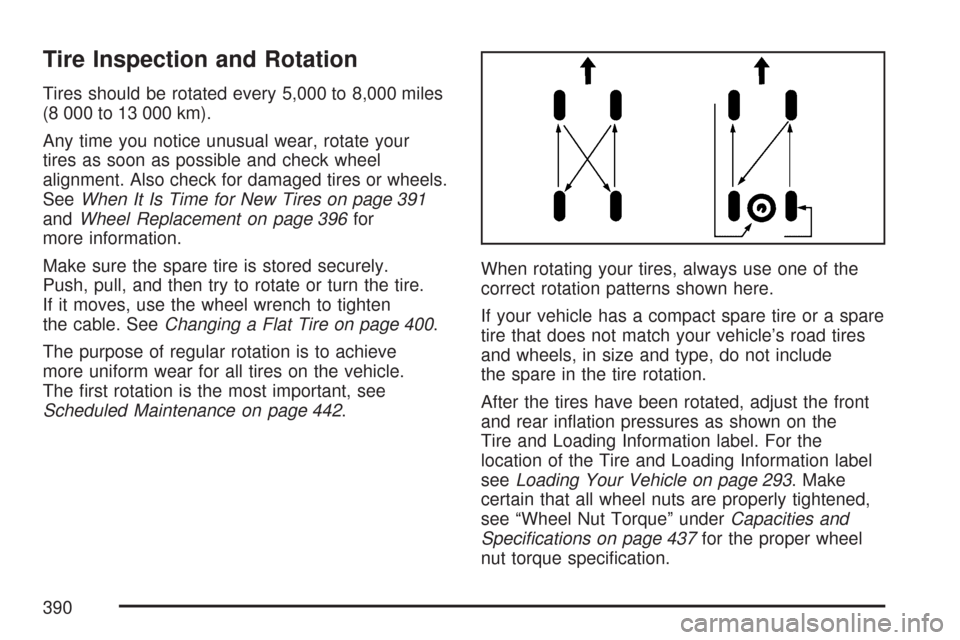
Tire Inspection and Rotation
Tires should be rotated every 5,000 to 8,000 miles
(8 000 to 13 000 km).
Any time you notice unusual wear, rotate your
tires as soon as possible and check wheel
alignment. Also check for damaged tires or wheels.
SeeWhen It Is Time for New Tires on page 391
andWheel Replacement on page 396for
more information.
Make sure the spare tire is stored securely.
Push, pull, and then try to rotate or turn the tire.
If it moves, use the wheel wrench to tighten
the cable. SeeChanging a Flat Tire on page 400.
The purpose of regular rotation is to achieve
more uniform wear for all tires on the vehicle.
The �rst rotation is the most important, see
Scheduled Maintenance on page 442.When rotating your tires, always use one of the
correct rotation patterns shown here.
If your vehicle has a compact spare tire or a spare
tire that does not match your vehicle’s road tires
and wheels, in size and type, do not include
the spare in the tire rotation.
After the tires have been rotated, adjust the front
and rear in�ation pressures as shown on the
Tire and Loading Information label. For the
location of the Tire and Loading Information label
seeLoading Your Vehicle on page 293. Make
certain that all wheel nuts are properly tightened,
see “Wheel Nut Torque” underCapacities and
Speci�cations on page 437for the proper wheel
nut torque speci�cation.
390
Page 396 of 496
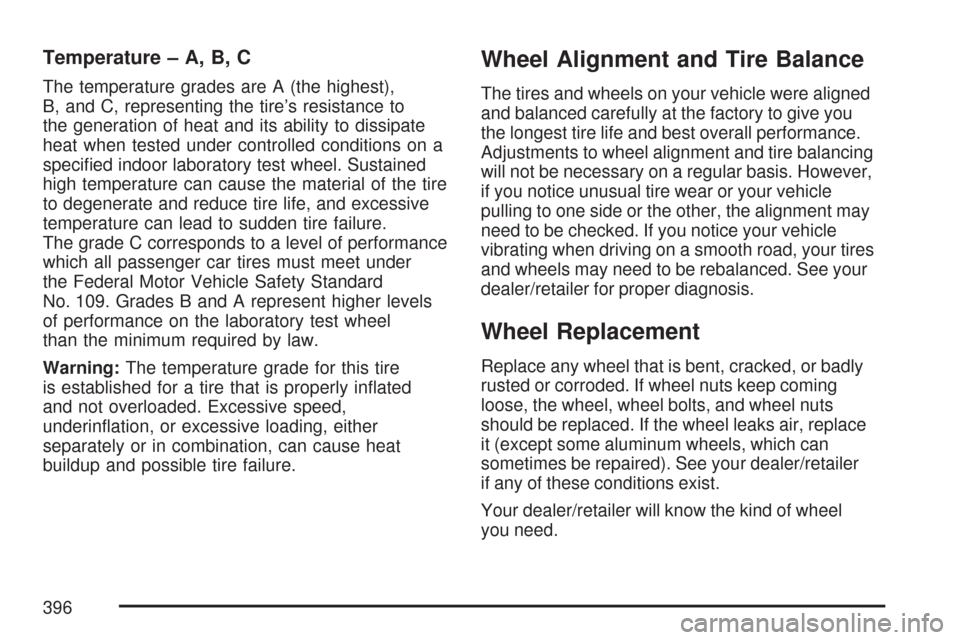
Temperature – A, B, C
The temperature grades are A (the highest),
B, and C, representing the tire’s resistance to
the generation of heat and its ability to dissipate
heat when tested under controlled conditions on a
speci�ed indoor laboratory test wheel. Sustained
high temperature can cause the material of the tire
to degenerate and reduce tire life, and excessive
temperature can lead to sudden tire failure.
The grade C corresponds to a level of performance
which all passenger car tires must meet under
the Federal Motor Vehicle Safety Standard
No. 109. Grades B and A represent higher levels
of performance on the laboratory test wheel
than the minimum required by law.
Warning:The temperature grade for this tire
is established for a tire that is properly in�ated
and not overloaded. Excessive speed,
underin�ation, or excessive loading, either
separately or in combination, can cause heat
buildup and possible tire failure.
Wheel Alignment and Tire Balance
The tires and wheels on your vehicle were aligned
and balanced carefully at the factory to give you
the longest tire life and best overall performance.
Adjustments to wheel alignment and tire balancing
will not be necessary on a regular basis. However,
if you notice unusual tire wear or your vehicle
pulling to one side or the other, the alignment may
need to be checked. If you notice your vehicle
vibrating when driving on a smooth road, your tires
and wheels may need to be rebalanced. See your
dealer/retailer for proper diagnosis.
Wheel Replacement
Replace any wheel that is bent, cracked, or badly
rusted or corroded. If wheel nuts keep coming
loose, the wheel, wheel bolts, and wheel nuts
should be replaced. If the wheel leaks air, replace
it (except some aluminum wheels, which can
sometimes be repaired). See your dealer/retailer
if any of these conditions exist.
Your dealer/retailer will know the kind of wheel
you need.
396
Page 495 of 496
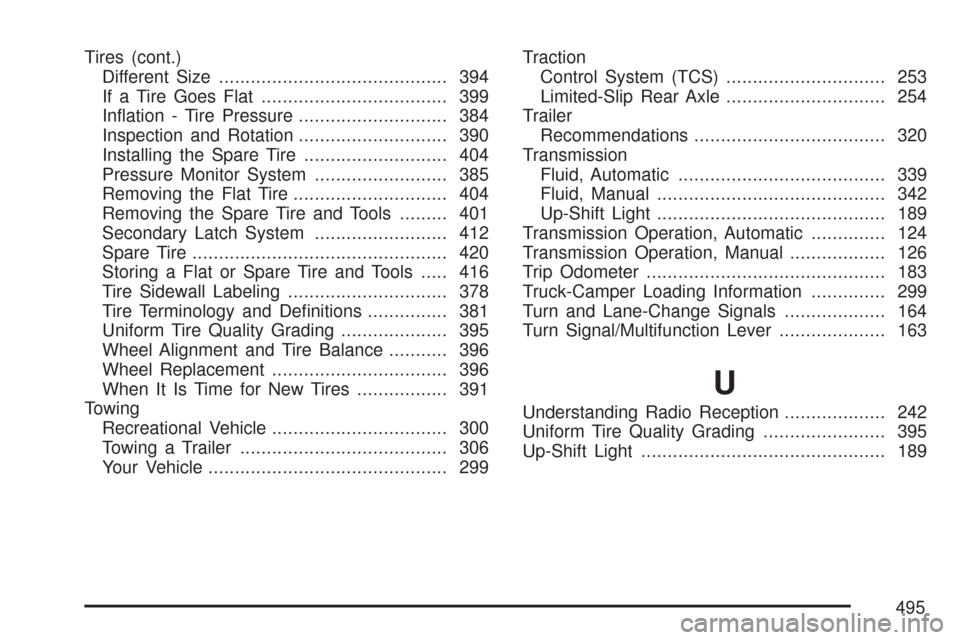
Tires (cont.)
Different Size........................................... 394
If a Tire Goes Flat................................... 399
In�ation - Tire Pressure............................ 384
Inspection and Rotation............................ 390
Installing the Spare Tire........................... 404
Pressure Monitor System......................... 385
Removing the Flat Tire............................. 404
Removing the Spare Tire and Tools......... 401
Secondary Latch System......................... 412
Spare Tire................................................ 420
Storing a Flat or Spare Tire and Tools..... 416
Tire Sidewall Labeling.............................. 378
Tire Terminology and De�nitions............... 381
Uniform Tire Quality Grading.................... 395
Wheel Alignment and Tire Balance........... 396
Wheel Replacement................................. 396
When It Is Time for New Tires................. 391
Towing
Recreational Vehicle................................. 300
Towing a Trailer....................................... 306
Your Vehicle............................................. 299Traction
Control System (TCS).............................. 253
Limited-Slip Rear Axle.............................. 254
Trailer
Recommendations.................................... 320
Transmission
Fluid, Automatic....................................... 339
Fluid, Manual........................................... 342
Up-Shift Light........................................... 189
Transmission Operation, Automatic.............. 124
Transmission Operation, Manual.................. 126
Trip Odometer............................................. 183
Truck-Camper Loading Information.............. 299
Turn and Lane-Change Signals................... 164
Turn Signal/Multifunction Lever.................... 163
U
Understanding Radio Reception................... 242
Uniform Tire Quality Grading....................... 395
Up-Shift Light.............................................. 189
495
Page 496 of 496
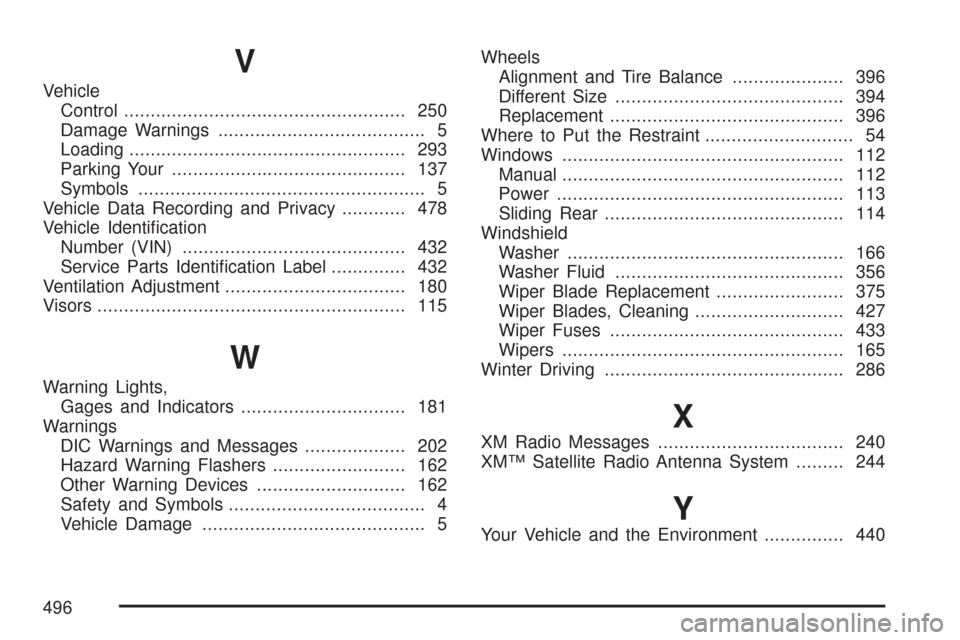
V
Vehicle
Control..................................................... 250
Damage Warnings....................................... 5
Loading.................................................... 293
Parking Your............................................ 137
Symbols...................................................... 5
Vehicle Data Recording and Privacy............ 478
Vehicle Identi�cation
Number (VIN).......................................... 432
Service Parts Identi�cation Label.............. 432
Ventilation Adjustment.................................. 180
Visors.......................................................... 115
W
Warning Lights,
Gages and Indicators............................... 181
Warnings
DIC Warnings and Messages................... 202
Hazard Warning Flashers......................... 162
Other Warning Devices............................ 162
Safety and Symbols..................................... 4
Vehicle Damage.......................................... 5Wheels
Alignment and Tire Balance..................... 396
Different Size........................................... 394
Replacement............................................ 396
Where to Put the Restraint............................ 54
Windows..................................................... 112
Manual..................................................... 112
Power...................................................... 113
Sliding Rear............................................. 114
Windshield
Washer.................................................... 166
Washer Fluid........................................... 356
Wiper Blade Replacement........................ 375
Wiper Blades, Cleaning............................ 427
Wiper Fuses............................................ 433
Wipers..................................................... 165
Winter Driving............................................. 286
X
XM Radio Messages................................... 240
XM™ Satellite Radio Antenna System......... 244
Y
Your Vehicle and the Environment............... 440
496